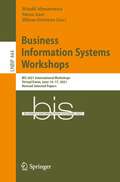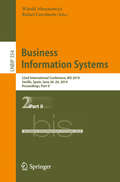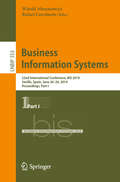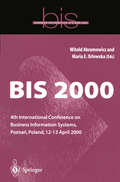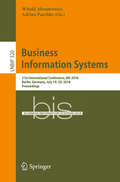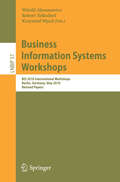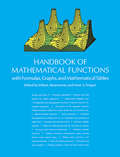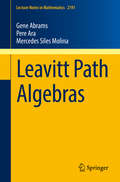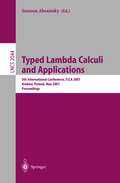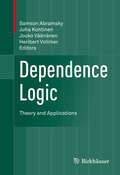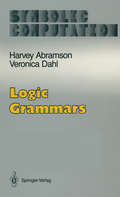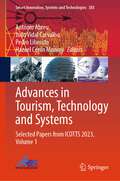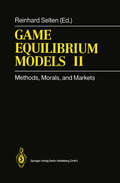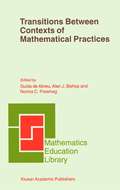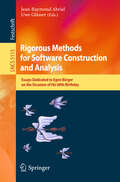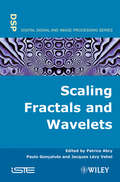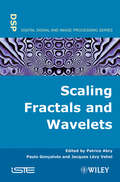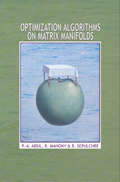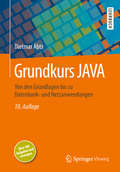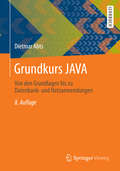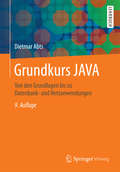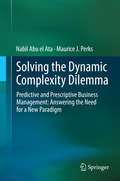- Table View
- List View
Business Information Systems Workshops: BIS 2021 International Workshops, Virtual Event, June 14–17, 2021, Revised Selected Papers (Lecture Notes in Business Information Processing #444)
by Witold Abramowicz Sören Auer Milena StróżynaThis book constitutes revised papers from the eight workshops which were held during June 2021 at the 24th International Conference on Business Information Systems, BIS 2021. The conference was planned to take place in Hannover, Germany, and changed to a fully online event due to the COVID-19 pandemic. There was a total of 67 submissions to all workshops of which 31papers were accepted for publication. The workshops included in this volume are: AKTB 2021: 12th Workshop on Applications of Knowledge-Based Technologies in Business BisEd 2021: BIS Education: Trends and Challenges DigBD 2021: 1st Workshop on Digitization in the Flux of Big Data Scenarios DigEx 2021: 3rd International Workshop on transforming the Digital Customer Experience iCRM 2021: 6th International Workshop on Integrated Social CRM QOD 2021: 4th Workshop on Quality of Open Data BITA 2021: 12th Workshop on Business and IT Alignment BSCT 2021: 4th Workshop on Blockchain and Smart Contract Technologies
Business Information Systems: 22nd International Conference, BIS 2019, Seville, Spain, June 26–28, 2019, Proceedings, Part II (Lecture Notes in Business Information Processing #354)
by Witold Abramowicz Rafael CorchueloThe two-volume set LNBIP 353 and 354 constitutes the proceedings of the 22nd International Conference on Business Information Systems, BIS 2019, held in Seville, Spain, in June 2019. The theme of the BIS 2019 was "Data Science for Business Information Systems", inspiring researchers to share theoretical and practical knowledge of the different aspects related to Data Science in enterprises. The 67 papers presented in these proceedings were carefully reviewed and selected from 223 submissions. The contributions were organized in topical sections as follows: Part I: Big Data and Data Science; Artificial Intelligence; ICT Project Management; and Smart Infrastructure. Part II: Social Media and Web-based Systems; and Applications, Evaluations and Experiences.
Business Information Systems: 22nd International Conference, BIS 2019, Seville, Spain, June 26–28, 2019, Proceedings, Part I (Lecture Notes in Business Information Processing #353)
by Witold Abramowicz Rafael CorchueloThe two-volume set LNBIP 353 and 354 constitutes the proceedings of the 22nd International Conference on Business Information Systems, BIS 2019, held in Seville, Spain, in June 2019. The theme of the BIS 2019 was "Data Science for Business Information Systems", inspiring researchers to share theoretical and practical knowledge of the different aspects related to Data Science in enterprises. The 67 papers presented in these proceedings were carefully reviewed and selected from 223 submissions. The contributions were organized in topical sections as follows: Part I: Big Data and Data Science; Artificial Intelligence; ICT Project Management; and Smart Infrastructure. Part II: Social Media and Web-based Systems; and Applications, Evaluations and Experiences.
BIS 2000: 4th International Conference on Business Information Systems, Pozna?, Poland, 12–13 April 2000
by Witold Abramowicz Maria E. OrlowskaThis volume contains papers presented during the science trace at the 4th International Conference of Business Information Systems, BIS 2000, held in Poznan, Poland, 12-13 April 2000, which discussed the development, implementation, applications and improvement of computer systems for business processes.The papers deal with practical, industry experiences and validated prototype implementations, and cover areas such as integration of information systems, electronic transactions and banking, virtual organisations, network technologies, business information systems modelling and analysis.
Business Information Systems: 21st International Conference, BIS 2018, Berlin, Germany, July 18-20, 2018, Proceedings (Lecture Notes in Business Information Processing #320)
by Witold Abramowicz Adrian PaschkeThis book constitutes the proceedings of the 21st International Conference on Business Information Systems, BIS 2018, held in Berlin, Germany, in July 2018. The BIS conference follows popular research trends, both in the academic and the business domain. Thus the theme of BIS 2018 was "Digital Transformation - An Imperative in Today's Business Markets". The 30 papers presented in this volume were carefully reviewed and selected from 96 submissions. They were organized in topical sections named: big and smart data and artificial intelligence; business and enterprise modeling; ICT project management; process management; smart infrastructures; social media and Web-based business information systems; applications, evaluations, and experiences.
Business Information Systems Workshops: BIS 2010 International Workshop, Berlin, Germany, May 3-5, 2010, Revised Papers (Lecture Notes in Business Information Processing #57)
by Witold Abramowicz Robert Tolksdorf Krzysztof WecelBusiness information systems is a rapidly developing domain. There are many topicsthatdeserveattentionbuthavenotyetfoundaplaceincanonicalresearch. Workshops give researchers the possibility to share preliminary ideas, ?rst - perimental results, or to discuss research hypotheses. Discussions held during presentations strengthen the paper and prepare it for publication. From our - perience, workshops are a perfect instrument with which to create a community aroundvery speci?c researchtopics, thus o?ering the opportunity to promote it. Topics that do not ?nd critical feedback at the main International Conference on Business Information Systems (BIS) may experience fruitful discussion when confronted with a well-focused audience. Over the last few decades, business informationsystems have been one of the most important factors of the transition toward a knowledge-based economy. At the same time they have been subject to continuous rapid development and innovation driven both by industry and by academia. For the last 12 years these innovations were carefully observed but also shaped by researchers attending BIS yearly.
Handbook of Mathematical Functions: with Formulas, Graphs, and Mathematical Tables
by Milton Abramowitz Irene A. StegunDespite the increasing use of computers, the basic need for mathematical tables continues. Tables serve a vital role in preliminary surveys of problems before programming for machine operation, and they are indispensable to thousands of engineers and scientists without access to machines. Because of automatic computers, however, and because of recent scientific advances, a greater variety of functions and a higher accuracy of tabulation than have been available until now are required.In 1954, a conference on mathematical tables, sponsored by M.I.T. and the National Science Foundation, met to discuss a modernization and extension of Jahnke and Emde's classical tables of functions. This volume, published 10 years later by the U.S. Department of Commerce, is the result. Designed to include a maximum of information and to meet the needs of scientists in all fields, it is a monumental piece of work, a comprehensive and self-contained summary of the mathematical functions that arise in physical and engineering problems.The book contains 29 sets of tables, some to as high as 20 places: mathematical constants; physical constants and conversion factors (6 tables); exponential integral and related functions (7); error function and Fresnel integrals (12); Bessel functions of integer (12) and fractional (13) order; integrals of Bessel functions (2); Struve and related functions (2); confluent hypergeometric functions (2); Coulomb wave functions (2); hypergeometric functions; Jacobian elliptic and theta functions (2); elliptic integrals {9); Weierstrass elliptic and related functions; parabolic cylinder functions {3); Mathieu functions (2); spheroidal wave functions (5); orthogonal polynomials (13); combinatorial analysis (9); numerical interpolation, differentiation and integration (11); probability functions (ll); scales of notation (6); miscellaneous functions (9); Laplace transforms (2); and others.Each of these sections is prefaced by a list of related formulas and graphs: differential equations, series expansions, special functions, and other basic relations. These constitute an unusually valuable reference work in themselves. The prefatory material also includes an explanation of the numerical methods involved in using the tables that follow and a bibliography. Numerical examples illustrate the use of each table and explain the computation of function values which lie outside its range, while the editors' introduction describes higher-order interpolation procedures. Well over100 figures illustrate the text.In all, this is one of the most ambitious and useful books of its type ever published, an essential aid in all scientific and engineering research, problem solving, experimentation and field work. This low-cost edition contains every page of the original government publication.
Leavitt Path Algebras (Lecture Notes in Mathematics #2191)
by Gene Abrams Pere Ara Mercedes Siles MolinaThis book offers a comprehensive introduction by three of the leading experts in the field, collecting fundamental results and open problems in a single volume.Since Leavitt path algebras were first defined in 2005, interest in these algebras has grown substantially, with ring theorists as well as researchers working in graph C*-algebras, group theory and symbolic dynamics attracted to the topic. Providing a historical perspective on the subject, the authors review existing arguments, establish new results, and outline the major themes and ring-theoretic concepts, such as the ideal structure, Z-grading and the close link between Leavitt path algebras and graph C*-algebras. The book also presents key lines of current research, including the Algebraic Kirchberg Phillips Question, various additional classification questions, and connections to noncommutative algebraic geometry.Leavitt Path Algebras will appeal to graduate students and researchers working in the field and related areas, such as C*-algebras and symbolic dynamics. With its descriptive writing style, this book is highly accessible.
AQA Core Maths — AQA Level 3 Mathematical Studies Student Book (Aqa Core Maths Ser.)
by Jack Abramsky Huw Kyffin Helen Ball Kevin Davis Peter RansomExam Board: AQA Level & Subject: Level 3 Maths First teaching: September 2014 First exams: June 2016 AQA approved Engage and motivate your AQA Core Maths students with a rich variety of real-life data and contexts. • Help students to access the AQA Level 3 Mathematical Studies specification with explanations, examples and plenty of practice. • Help all students reach their potential with differentiated exercises and project work. • Capture students’ interest with a real-world chapter opener and Mathematics in the real world sections throughout • Prepare for exams with exam-style questions in chapter 14 • Get students talking with Discussions that include open-ended questions • Focus on technical vocabulary and unfamiliar terms with key term definitions on the page • Draw together learning from each chapter with a Case Study • Provide extended tasks with the Project work sections at the end of each chapter • Assess your learning before moving on with the Check your progress feature • Check your understanding with answers at the back
Typed Lambda Calculi and Applications: 5th International Conference, TLCA 2001 Krakow, Poland, May 2-5, 2001 Proceedings (Lecture Notes in Computer Science #2044)
by Samson AbramskyThis book constitutes the refereed proceedings of the 5th International Conference on Typed Lambda Calculi and Applications, TLCA 2001, held in Krakow, Poland in May 2001. The 28 revised full papers presented were carefully reviewed and selected from 55 submissions. The volume reports research results on all current aspects of typed lambda calculi. Among the topics addressed are type systems, subtypes, coalgebraic methods, pi-calculus, recursive games, various types of lambda calculi, reductions, substitutions, normalization, linear logic, cut-elimination, prelogical relations, and mu calculus.
Dependence Logic: Theory and Applications
by Samson Abramsky Juha Kontinen Jouko Väänänen Heribert VollmerIn this volume, different aspects of logics for dependence and independence are discussed, including both the logical and computational aspects of dependence logic, and also applications in a number of areas, such as statistics, social choice theory, databases, and computer security. The contributing authors represent leading experts in this relatively new field, each of whom was invited to write a chapter based on talks given at seminars held at the Schloss Dagstuhl Leibniz Center for Informatics in Wadern, Germany (in February 2013 and June 2015) and an Academy Colloquium at the Royal Netherlands Academy of Arts and Sciences (March 2014). Altogether, these chapters provide the most up-to-date look at this developing and highly interdisciplinary field and will be of interest to a broad group of logicians, mathematicians, statisticians, philosophers, and scientists. Topics covered includea comprehensive survey of many propositional, modal, and first-order variants of dependence logic;new results concerning expressive power of several variants of dependence logic with different sets of logical connectives and generalized dependence atoms;connections between inclusion logic and the least-fixed point logic;an overview of dependencies in databases by addressing the relationships between implication problems for fragments of statistical conditional independencies, embedded multivalued dependencies, and propositional logic;various Markovian models used to characterize dependencies and causality among variables in multivariate systems;applications of dependence logic in social choice theory; andan introduction to the theory of secret sharing, pointing out connections to dependence and independence logic.
Logic Grammars (Symbolic Computation)
by Harvey Abramson Veronica DahlLogic grammars have found wide application both in natural language processing and in formal applications such as compiler writing. This book introduces the main concepts involving natural and formal language processing in logic programming, and discusses typical problems which the reader may encounter, proposing various methods for solving them. The basic material is presented in depth; advanced material, involving new logic grammar formalisms and applications, is presented with a view towards breadth. Major sections of the book include: grammars for formal language and linguistic research, writing a simple logic grammar, different types of logic grammars, applications, and logic grammars and concurrency. This book is intended for those interested in logic programming, artificial intelligence, computational linguistics, Fifth Generation computing, formal languages and compiling techniques. It may be read profitably by upper-level undergraduates, post-graduate students, and active researchers on the above-named areas. Some familiarity with Prolog and logic programming would be helpful; the authors, however, briefly describe Prolog and its relation to logic grammars. After reading Logic Grammars, the reader will be able to cope with the ever-increasing literature of this new and exciting field.
Advances in Tourism, Technology and Systems: Selected Papers from ICOTTS 2023, Volume 1 (Smart Innovation, Systems and Technologies #383)
by António Abreu João Vidal Carvalho Pedro Liberato Hazael Cerón MonroyThis book features a collection of high-quality research papers presented at the International Conference on Tourism, Technology and Systems (ICOTTS 2023), held at Anáhuac University, Bacalar, Mexico, from 2 to 4 November 2023. The book is divided into two volumes, and it covers the areas of technology in tourism and the tourist experience, generations and technology in tourism, digital marketing applied to tourism and travel, mobile technologies applied to sustainable tourism, information technologies in tourism, digital transformation of tourism business, e-tourism and tourism 2.0, big data and management for travel and tourism, geotagging and tourist mobility, smart destinations, robotics in tourism, and information systems and technologies.
Game Equilibrium Models II: Methods, Morals, and Markets
by D. Abreu W. Albers K. Binmore R. Gardner W. Güth R. M. Harstad H. Kliemt W. Leininger A. Okada E. Ostrom D. Pearce L. Philips S. H. Schanuel L. K. Simon J. Sobel G. Stephan E. Van Damme J. W. Walker F. Weissing W. R. ZameTransitions Between Contexts of Mathematical Practices (Mathematics Education Library #27)
by Guida De Abreu Norma C. PresmegThis book discusses mathematics learners in transition and their practices in different contexts; the institutional and socio-cultural framing of the transition processes involved; and the communication and negotiation of mathematical meanings during transition. Providing both empirical studies and significant theoretical reflections, it will appeal to researchers and postgraduate students in mathematics education, cultural psychology, multicultural education, immigrant and indigenous education.
Rigorous Methods for Software Construction and Analysis: Essays Dedicated to Egon Börger on the Occasion of His 60th Birthday (Lecture Notes in Computer Science #5115)
by Jean-Raymond Abrial Uwe GlässerLogica: Volume 1 - Dimostrazioni E Modelli Al Primo Ordine (UNITEXT #80)
by Vito Michele Abrusci Lorenzo Tortora de FalcoL'opera si propone come testo di riferimento per acquisire una solida preparazione specialistica nella Logica, presentando in maniera rigorosa ed innovativa argomenti tradizionalmente affrontati nei corsi universitari di secondo livello. Questo secondo volume, che completa l'opera, presenta le basi della teoria della ricorsività, l'aritmetica di Peano ed i teoremi di incompletezza, gli assiomi della teoria assiomatica degli insiemi di Zermelo-Fraenkel e la teoria degli ordinali e dei cardinali che ne deriva.
Logica: Volume 1 - Dimostrazioni e modelli al primo ordine (UNITEXT #80)
by Vito Michele Abrusci Lorenzo Tortora de FalcoGli autori, basandosi sulla loro esperienza di ricerca, propongono in due volumi un testo di riferimento per acquisire una solida formazione specialistica nella logica.Nei due volumi vengono presentati in maniera innovativa e rigorosa temi di logica tradizionalmente affrontati nei corsi universitari di secondo livello.Questo primo volume è dedicato ai teoremi fondamentali sulla logica del primo ordine e alle loro principali conseguenze.Il testo è rivolto in particolare agli studenti dei corsi di laurea magistrale.
Scaling, Fractals and Wavelets
by Patrice Abry Paolo Goncalves Jacques Levy VehelScaling is a mathematical transformation that enlarges or diminishes objects. The technique is used in a variety of areas, including finance and image processing. This book is organized around the notions of scaling phenomena and scale invariance. The various stochastic models commonly used to describe scaling ? self-similarity, long-range dependence and multi-fractals ? are introduced. These models are compared and related to one another. Next, fractional integration, a mathematical tool closely related to the notion of scale invariance, is discussed, and stochastic processes with prescribed scaling properties (self-similar processes, locally self-similar processes, fractionally filtered processes, iterated function systems) are defined. A number of applications where the scaling paradigm proved fruitful are detailed: image processing, financial and stock market fluctuations, geophysics, scale relativity, and fractal time-space.
Scaling, Fractals and Wavelets (Iste Ser.)
by Patrice Abry Paulo Gonçalves Jacques Lévy VéhelScaling is a mathematical transformation that enlarges or diminishes objects. The technique is used in a variety of areas, including finance and image processing. This book is organized around the notions of scaling phenomena and scale invariance. The various stochastic models commonly used to describe scaling ? self-similarity, long-range dependence and multi-fractals ? are introduced. These models are compared and related to one another. Next, fractional integration, a mathematical tool closely related to the notion of scale invariance, is discussed, and stochastic processes with prescribed scaling properties (self-similar processes, locally self-similar processes, fractionally filtered processes, iterated function systems) are defined. A number of applications where the scaling paradigm proved fruitful are detailed: image processing, financial and stock market fluctuations, geophysics, scale relativity, and fractal time-space.
Optimization Algorithms on Matrix Manifolds
by P. A. Absil R. Mahony R. SepulchreMany problems in the sciences and engineering can be rephrased as optimization problems on matrix search spaces endowed with a so-called manifold structure. This book shows how to exploit the special structure of such problems to develop efficient numerical algorithms. It places careful emphasis on both the numerical formulation of the algorithm and its differential geometric abstraction--illustrating how good algorithms draw equally from the insights of differential geometry, optimization, and numerical analysis. Two more theoretical chapters provide readers with the background in differential geometry necessary to algorithmic development. In the other chapters, several well-known optimization methods such as steepest descent and conjugate gradients are generalized to abstract manifolds. The book provides a generic development of each of these methods, building upon the material of the geometric chapters. It then guides readers through the calculations that turn these geometrically formulated methods into concrete numerical algorithms. The state-of-the-art algorithms given as examples are competitive with the best existing algorithms for a selection of eigenspace problems in numerical linear algebra. Optimization Algorithms on Matrix Manifolds offers techniques with broad applications in linear algebra, signal processing, data mining, computer vision, and statistical analysis. It can serve as a graduate-level textbook and will be of interest to applied mathematicians, engineers, and computer scientists.
Grundkurs JAVA: Von den Grundlagen bis zu Datenbank- und Netzanwendungen
by Dietmar AbtsOb Unternehmenssoftware, Webanwendungen, technische Systeme oder mobile Anwendungen wie Apps – Java ist eine universelle Programmiersprache für die unterschiedlichsten Anwendungen. Der große Vorteil: in Java programmierte Anwendungen sind auf nahezu allen Rechnersystemen lauffähig.Mit diesem Buch lernen Sie Schritt für Schritt die wichtigsten Aspekte von Java auf der Basis der Standard-Edition Java SE 9 kennen. Angefangen bei den allgemeinen Eigenschaften von Java und der grundsätzlichen Vorgehensweise bei der Erzeugung eines lauffähigen Programms führt der Autor imperative und objektorientierte Sprachkonzepte ein. Er behandelt die Entwicklung von grafischen Oberflächen genauso wie die Programmierung von Client/Server-Anwendungen und erläutert den Zugriff auf relationale Datenbanken mit Hilfe von SQL. Nahezu jedes Kapitel enthält am Ende Aufgaben, mit denen Leser den behandelten Stoff einüben und vertiefen können. Mehr als 200 Übungen unterstützen das Lernen, zahlreiche Beispielprogramme helfen bei der Umsetzung der Konzepte in lauffähige Anwendungen. Der vollständige Quellcode der im Buch behandelten Programme (125 Projekte) und die Lösungen zu den Aufgaben sind auf der Webseite zum Buch verfügbar.Mit Java 9 wurden Module als neues Feature in die Programmiersprache eingeführt. Die 10. Auflage des Buchs behandelt das Java-Modulsystem in einem eigenen Kapitel. Zudem wurden zahlreiche Ergänzungen wie die API- und Syntax-Erweiterungen in die Neuauflage eingearbeitet.Das Buch richtet sich an Studierende der Informatik und der Wirtschaftsinformatik sowie an IT-Beschäftigte in Ausbildung und Beruf. Und an alle, die bereits grundlegende Kenntnisse in einer Programmiersprache haben und auf Java umsteigen möchten.
Grundkurs JAVA: Von den Grundlagen bis zu Datenbank- und Netzanwendungen
by Dietmar AbtsLernen Sie schrittweise die wichtigsten Aspekte von Java kennen, von den elementaren Grundlagen über objektorientierte Konzepte und grafische Benutzungsoberflächen bis zu Datenbankanwendungen und Kommunikation im Netzwerk. Der Grundkurs schließt mit zwei ausführlichen Einführungen zu aktuellen Themen: das Persistenz-Framework JPA zur Speicherung von Objekten in relationalen Datenbanken und die Objektdatenbank db4o.In der 8. Auflage werden die mit Java 8 eingeführten Default-Methoden und Lambda-Ausdrücke behandelt. Außerdem wurden zahlreiche Verbesserungen und Ergänzungen vorgenommen.Der Quellcode von über 350 Programmbeispielen (inkl. Lösungen zu den Aufgaben) ist im Internet verfügbar.
Grundkurs JAVA: Von den Grundlagen bis zu Datenbank- und Netzanwendungen
by Dietmar AbtsLernen Sie mit diesem Buch schrittweise die wichtigsten Aspekte von Java kennen, von den elementaren Grundlagen über objektorientierte Konzepte und grafische Benutzungsoberflächen bis zu Datenbankanwendungen und Kommunikation im Netzwerk.Die 9. Auflage enthält eine Einführung zu JavaFX, dem aktuellen Framework zur Entwicklung moderner grafischer Oberflächen. Zahlreiche Verbesserungen und Ergänzungen wurden vorgenommen.Der Quellcode von 387 Programmbeispielen (inkl. Lösungen zu den Aufgaben) ist im Internet verfügbar.
Solving the Dynamic Complexity Dilemma: Predictive and Prescriptive Business Management: Answering the Need for a New Paradigm
by Nabil Abu el Ata Maurice J. PerksDynamic complexity results from hidden, unknown factors—or more precisely, interactions between factors—that can unexpectedly impact the performance of systems. When the influences of dynamic complexity are not measured and understood, new never-seen-before behaviors can come as unwelcomed surprises, which disrupt the performance of systems. Left alone, processes that were once prized for their efficiency unexpectedly begin to degrade—costs increase, while volumes and quality decline. Evidence of problems may come too late for effective resolution as technology advancements induce rapid change and compress the time available to react to that change. The results of dynamic complexity are always negative and unmanaged dynamic complexity can bring business or global systems to the point of sudden chaos. The 2009 H1N1 pandemic, 2008 Credit Crunch and 2011 Fukushima Daiichi nuclear disaster are global examples of the dangers of undiagnosed dynamic complexity.With increasing frequency executive leaders today are discovering that their business and IT system performance levels are not meeting expectations. In most cases these performance deficiencies are caused by dynamic complexity, which lies hidden like a cancer until the symptoms reveal themselves—often when it is too late to avoid negative impacts on business outcomes. This book examines the growing business problem of dynamic complexity and presents a path to a practical solution. To achieve better predictability, organizations must be able to expose new, dangerous patterns of behavior in time to take corrective actions and know which actions will yield the optimal results. The book authors promote new methods of risk management that use data collection, analytics, machine learning and automation processes to help organizations more accurately predict the future and take strategic actions to improve performance outcomes. The presented means of achieving this goal are based upon the authors’ practical experiences, backed by scientific principles, and results achieved through consulting engagements with over 350 global organizations.
